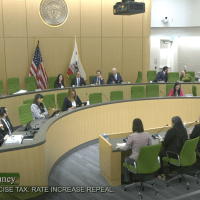This article is from Ca NORML’s November newsletter, sent to our members. To join, support Cal NORML and receive all the news, click here.
 |
Berkeley Patients Group is one medical marijuana dispenary that plans to open their doors to recreational users on January 1. |
November 2017 – New Year’s 2018 is ushering in a new era in California, as the first state-licensed cannabis stores open their doors and adult-use sales begin on Jan. 1, 2018. Officials at the Bureau of Cannabis Control published emergency regulations on November 16, so that it can issue the first licenses by January 1. (State rules and regulations are posted at the California Cannabis Portal.)
In order to qualify for state licenses, applicants must first get approval from their local governments. Hundreds of cities and counties are scrambling to finalize regulations, but a few have already given the go-ahead for adult-use sales at existing dispensaries on January 1, among them Berkeley, San Diego, Santa Cruz Co. and Humboldt Co. Other cities scrambling to meet the deadline are Oakland, San Francisco, San Jose, Santa Rosa, Long Beach, Richmond and Los Angeles. Numerous cities, including West Hollywood, Santa Ana and Sacramento are likely to join the adult-use bandwagon but may not be ready until after January 1.
Many localities, such as Santa Barbara, San Luis Obispo Co. and Mendocino Co. are permitting medical sales, but holding off on adult use for the time being (businesses can be licensed as medical-only, adult-only, or both).
The majority of governments in less urban areas have chosen to ban cannabis business entirely, leaving a cannabis desert in large swaths of the eastern state, Inland Empire and Central Valley.
A few cities, such as Oakland and San Francisco, are planning to allow on-site consumption in some dispensaries. Unlike other legal states, which provide users with no place to socialize, California’s specifically allows for on-site consumption by local option. On-site consumption clubs that don’t sell cannabis are already operating privately in some parts of the state.
The state will issue provisional licenses to dispensaries that can’t immediately comply with all regulations as of Jan. 1. This is necessary because licensed gardens won’t begin to have product until after they have been operating for at least a full crop cycle.
All in all, the transition to licensing will be a lengthy process extending over a couple of years. Existing medical dispensaries who currently operate as collectives under the Medical Marijuana Program Act (SB 420) will no longer be allowed to do so one year after the Bureau of Cannabis Control announces that licensing is in effect. At that point, a crackdown on unlicensed operators seems likely.
The transition to state licensing will fundamentally transform California’s cannabis industry, which for over forty years has operated on essentially unregulated, free-market, gray-market or black-market terms. Medical providers who have previously operated under the free-floating rules of SB 420 and Prop 215 will be required to comply with expensive new regulations such as seed-to-sale tracking, potency and contaminant testing, labeling, packaging and distribution requirements, and hefty new taxes. The total cost of the regulations alone is estimated at $524 per pound by the University of California Agricultural Issues Center.
In addition, new state taxes imposed by the Adult Use of Marijuana Act (AUMA) are expected to add another 25% to the price of legal cannabis. These include a new 15% excise tax on all retail sales, plus a $9.25/ounce cultivation tax on flowers (or $2.75/ounce for leaves).
In addition, consumers must pay the state’s regular 7.5%-to-9% sales tax. Medical users who have state ID cards are exempted from this tax, but not from the other new taxes in AUMA.
Finally, many local governments are imposing fees and taxes of their own, ranging as high as 20% on gross proceeds and $25 per square foot of cultivation area.
The net result will be a hefty price increase for consumers. An eighth of good quality cannabis that now sells for $35 in dispensaries could cost $50 to $60 after Jan. 1st (medical users with ID cards should be able to save up to $5 in sales tax).
Economists warn that such high taxes will encourage competition by unlicensed, untaxed growers. A report by the global credit-rating firm Fitch Ratings warns that combined state and local taxes could be as high as 45% in some places, driving consumers to the black market.
In the long term, California’s licensed market is expected to generate some $6 to $7 billion in business and $1 billion yearly in taxes. However, the high price of legal cannabis will afford rich opportunities for unlicensed growers to sell their crops illegally as they have for years. Some 80% of California’s pot is exported out of state. The out-of-state market will persist so long as cannabis is illegal in most of the U.S. California has thousands of experienced growers who lack the resources and money to become state licensed. There is every reason to expect they will continue their activities, illegally or as personal use growers, for years to come. In the meantime, consumers are advised to stock up before the New Year.



